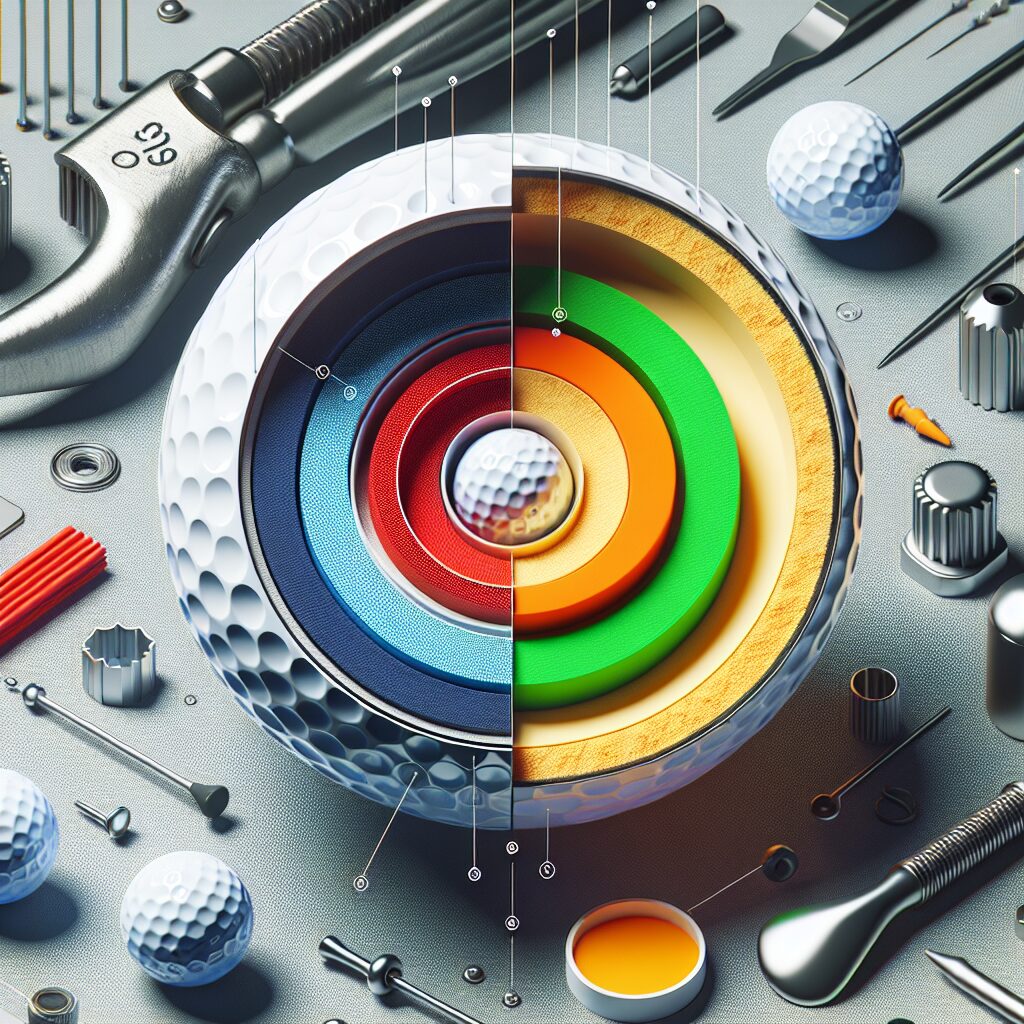Golf is a sport that has captivated the hearts of millions around the world. From amateurs to professionals, the game calls for precision, skill, and a deep understanding of various aspects, including the construction of the golf ball. The art of golf ball construction involves a careful selection of materials and the application of specific techniques to enhance performance and optimize the player’s experience on the course.
One of the most essential aspects of golf ball construction is the choice of materials. While the outer cover may be soft or hard, the inner core is typically made of rubber or synthetic materials. The outer cover, on the other hand, is often made of a material called Surlyn, which provides durability and control. These materials directly impact the performance of the golf ball, influencing factors such as distance, spin, and feel. The construction techniques employed in the manufacturing process also play a crucial role in creating a golf ball that meets the needs and preferences of golfers at different skill levels.
Now that we have touched upon the importance of golf ball construction and the materials and techniques involved, let’s explore some key takeaways. In the next sections, we will delve into the different types of materials used in golf ball construction and how they affect performance. We will also discuss various manufacturing techniques employed by leading golf ball manufacturers, highlighting the impact of these techniques on factors like distance, control, and durability. By gaining a deeper understanding of the art of golf ball construction, you can make informed choices when selecting the perfect golf ball to elevate your game. Stay tuned for an insightful exploration of these key aspects in the upcoming sections.
Key Takeaways
1. The construction of golf balls involves a multi-layered design that combines core, mantle, and cover materials to optimize performance.
2. The inner core, typically made of synthetic rubber or resin, plays a crucial role in determining the overall ball compression and feel.
3. Mantle layers, found between the core and cover, add spin control, distance, and stability to the ball’s flight by utilizing materials with different properties.
4. The cover, usually made of ionomer or urethane, influences the feel, durability, and spin rates of the ball, with softer covers providing more control.
5. The development of new materials and advanced manufacturing techniques has constantly pushed the boundaries of golf ball construction, leading to better performance and customization options for golfers.
What are the Materials and Techniques Used in the Art of Golf Ball Construction?
Golf Ball Construction Basics
In order to understand the art of golf ball construction, it is essential to have a grasp on the basic components and structure of a golf ball. A typical golf ball consists of several layers, each serving a specific purpose. These layers include the core, mantle, and cover. The construction of these layers and the materials used are vital in determining the performance and characteristics of the golf ball.
The Core: the Powerhouse of the Golf Ball
The core is the innermost layer of a golf ball and is responsible for providing the ball’s initial velocity and energy transfer upon impact. It is usually made of a high-energy rubber compound, which can vary in firmness. The core’s compression and resilience greatly affect the ball’s distance, feel, and spin rates.
The Mantle: Delivering Control and Consistency
Surrounding the core, the mantle layer plays a crucial role in shaping the ball’s behavior. It is typically made of a composite material, often a mixture of rubber and resin or additional layers of rubber. The mantle helps to control spin, enhance feel, and increase the ball’s overall consistency, especially during high-speed impacts.
The Cover: Aesthetic Appeal and Aerodynamic Performance
Outermost layer of a golf ball is the cover, which is responsible for providing a soft feel, durability, and control. Golf ball covers are generally made of either ionomer or urethane materials. Ionomer covers are more affordable and offer increased durability, while urethane covers provide superior spin control and feel.
Design and Dimples: Enhancing Flight Stability
The design and pattern of dimples on a golf ball are crucial in optimizing its aerodynamic properties and stability during flight. Dimple depth, size, and arrangement all influence the ball’s lift, drag, and trajectory. Manufacturers invest extensive research and testing to determine the most efficient dimple patterns for different golf ball models.
Techniques in Golf Ball Construction
The art of golf ball construction goes beyond materials; it also encompasses advanced techniques used by manufacturers to enhance performance. One such technique is dual core construction, where two cores with different compression levels are used to optimize distance and feel, catering to different players’ preferences. Furthermore, seamless cover technology minimizes inconsistencies and reduces drag, resulting in improved accuracy and distance.
Conclusion
- Choose the right golf ball construction based on your playing style and preferences.
- Consider the core compression and resilience for desired distance and feel.
- Assess the mantle and cover materials for improved control and consistency.
- Pay attention to the dimple design, as it affects flight stability.
- Stay updated on advancements in golf ball construction techniques to make informed choices.
Frequently Asked Questions
1. What materials are used in the construction of golf balls?
Golf balls are typically made of a solid core, which can be made from rubber or synthetic materials, surrounded by one or more layers of cover material such as surlyn or urethane.
2. How do different materials affect the performance of golf balls?
The materials used in golf ball construction can significantly impact their performance. For example, a soft cover material like urethane can provide more spin and control, while a harder cover like surlyn can enhance durability and distance.
3. Are there any specific techniques used in golf ball construction?
Yes, various techniques are employed in the manufacturing process of golf balls. These include compression molding, injection molding, and casting, each with its own advantages in terms of consistency, feel, and performance.
4. How does the construction of golf balls affect their flight characteristics?
The construction of golf balls can influence their flight characteristics, such as spin rate, trajectory, and distance. Factors like the number of layers, core design, and cover material all play a role in determining these flight characteristics.
5. Are there any regulations regarding the construction of golf balls?
Yes, golf ball construction is regulated by organizations like the USGA and R&A, which enforce limits on factors like size, weight, initial velocity, and overall performance. These regulations ensure fairness and consistency in the game.
6. Do different golf ball constructions suit different players?
Absolutely. Golf ball construction can be tailored to suit different players’ preferences and skill levels. Players with slower swing speeds may benefit from low compression balls, while advanced players may favor high-performance options that provide more control.
7. Can the construction of a golf ball affect its feel?
Yes, the construction of a golf ball can have a significant impact on its feel. Different materials and layer combinations can influence the softness or firmness of the ball, providing players with varying levels of feedback and responsiveness.
8. Are multi-layer golf balls better than single-layer ones?
Multi-layer golf balls offer advantages over single-layer ones in terms of performance. The additional layers allow for greater control over spin rates, increased distance, and enhanced feel, making them a popular choice among both amateur and professional golfers.
9. Are there eco-friendly materials used in golf ball construction?
Efforts have been made to incorporate eco-friendly materials in golf ball construction. Some manufacturers have started using recycled materials and more sustainable resources in their production processes, contributing to environmental conservation.
10. Can the construction of a golf ball impact its durability?
Yes, the construction of a golf ball plays a crucial role in determining its durability. The materials used in the cover and core, as well as the manufacturing techniques employed, influence how well a ball withstands the impact of shots and maintains its performance over time.
Final Thoughts
Understanding the art of golf ball construction is essential for both avid golfers and beginners. The materials and techniques utilized in their production directly impact the performance and feel of golf balls. By considering factors like compression, cover material, and construction technique, players can choose a ball that aligns with their individual needs and helps them achieve their desired results on the course.
Furthermore, advancements in golf ball construction continue to shape the game, pushing boundaries in terms of distance, control, and sustainability. Manufacturers constantly strive to develop innovative materials and construction methods to enhance the overall golfing experience. As technology evolves, it is exciting to witness how the art of golf ball construction will further evolve and contribute to the game’s continued growth and enjoyment.




